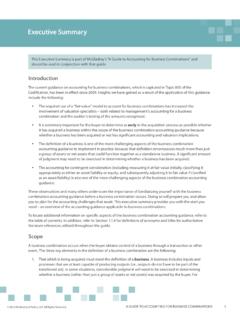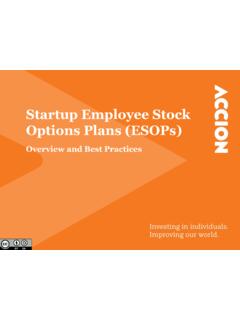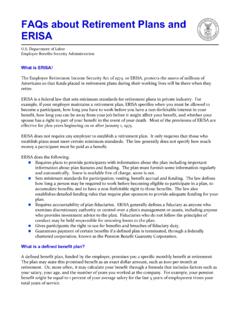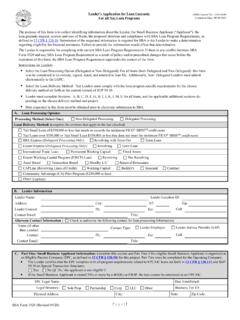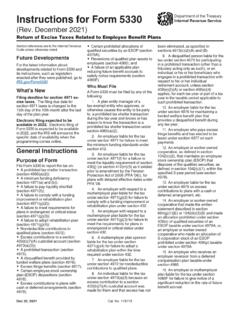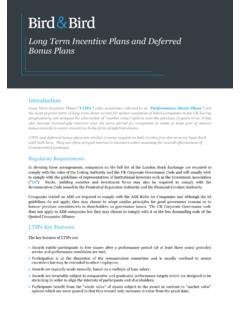Transcription of Accounting for ESOP transactions - RSM US
1 Accounting for ESOP transactions Prepared by: Rebecca Miller, Senior Director, RSM US LLP. +1 612 376 9327. This article was originally published in Leveraged ESOPs and employee Buyouts, and has been updated, revised and reprinted here with permission. Too frequently, the accountant is called into the picture after a rules are created. Most people have some understanding of leveraged employee stock ownership plan (ESOP) transaction how tax and employee Retirement Security Act of 1974 (ERISA). has been implemented and the financing obtained. To start regulations are written. If questioned on the Accounting rules, educating the plan sponsor on the Accounting treatment of however, those same people would have little idea of how an leveraged ESOPs at that late date is likely to be an unhappy Accounting principle is developed and what importance it has to experience.
2 By that time, the transaction may be too far down their financial future. the road to be able to avoid or minimize any potentially adverse Accounting treatment. Many people simply do not recognize Even after the Sarbanes-Oxley Act of 2002, the Accounting the dramatic impact that a leveraged ESOP will have on the profession remains a self-regulated professional group. In financial statements of the plan sponsor. an attempt to achieve uniformity, the profession establishes Generally Accepted Accounting Principles (GAAP). Most The purpose of this chapter is to describe the basics of Accounting standards are issued by the Financial Accounting Accounting for leveraged ESOP transactions so that potential Standards Board (FASB). FASB issues Statements of Financial plan sponsors and their advisors can anticipate the Accounting Accounting Standards, referred to as FASB Statements, and presentation and structure the transaction where possible to FASB Interpretations, referred to simply as Interpretations.
3 Minimize any complications created by the Accounting . This Before 2002, the next level of Accounting authority was issued chapter is only a primer on the rules covering the Accounting by the Accounting Standards Executive Committee (AcSEC) of for leveraged ESOPs and will not cover all of the intricacies the American Institute of Certified Public Accountants (AICPA). of very sophisticated ESOP applications. Nor will it go into This group issued Statements of Position, referred to as SOPs.. much detail on the Accounting for nonleveraged An SOP does not depart from the general rules established ESOP sponsors or potential sponsors will still need to get their by the FASB. Since 2002, AcSEC has only issued guidance on Accounting firms involved in the early stages of planning, as the industry-specific Accounting and auditing matters.
4 In 2009, sophisticated equity structures of many ESOP transactions will AcSEC was renamed as the Financial Reporting Executive create equally sophisticated financial reporting consequences Committee or FinREC. The last group authorized to issue beyond what is covered in this brief overview. Accounting authority is the Emerging Issues Task Force (EITF). of the FASB. This group is the least formal and is authorized Background only to interpret current standards. Such interpretations, however, do have the standing of GAAP. These interpretations Before describing the Accounting rules in detail, it may help are referred to as EITF issues. readers who are not accountants to understand how these The FASB provides for a public comment period before they 1 This chapter does not cover nonleveraged ESOPs because the financial release a statement.
5 When comments are received, the staff reporting for such transactions is substantially similar to a profit sharing reviews them. Changes may be proposed in response to plans. Sponsors on nonleveraged ESOPs should, however, pay attention such comments. In any event, any standard passes in front to the footnote requirements discussed later in this Chapter, as those of the applicable board or boards before final approval. If the requirements apply to all ESOPs, leveraged or not. public comments raise serious issues that result in major modifications in a proposal, a second comment period may be of Accounting . This might be, for example, cash basis, modified provided before finalizing a standard. cash basis or income tax basis. Commercial lenders, typically, require GAAP basis financial statements, so the remainder of A FASB Interpretation can be released without any public this chapter focuses on that manner of presentation.
6 Comment but generally involves significant time in drafting. The EITF, on the other hand, can respond quite quickly. It holds Specific ESOP Accounting authority approximately 10 meetings every year. If consensus can be reached at a single meeting, new GAAP may be created. From 1976 until 1989, the Accounting for ESOP transactions was controlled by Statement of Position 76-3, Accounting Practices In 2009, all GAAP in whatever form (FASB, SOP, EITF, etc.) was for Certain employee Stock ownership Plans, published by combined into a single document. This is the Financial Accounting the AICPA in 1976. This was issued before the Internal Revenue Standards Codification or ASC. Practitioners are gradually Service (IRS) and the Department of Labor (DOL) had finalized becoming familiar with this structure. To the person unfamiliar their regulations governing the operation of leveraged ESOPs.
7 With Accounting standards, this may be very helpful, as all This statement, referred to as SOP 76-3, was later affirmed as literature on a specific topic is covered by a single section of the GAAP by Statement of Financial Accounting Standard No. 32. Codification. The user no longer has to search through the FASBs, SOPs, EITF consensus opinions, FASB Staff Interpretations, etc. to At the time that SOP 76-3 was issued, because ESOPs were ascertain the governing provisions on that topic. quite new, most of them were very simple arrangements. All of the later activity involving convertible preferred stock, debt Besides these private entities, the Securities Exchange service with deductible dividends, reduced interest loans, Commission (SEC) issues Accounting pronouncements for immediate allocation loans, and so on was not yet encouraged public companies.
8 These releases typically concern issues through special tax incentives. Therefore, most of the plans relevant to the public market. However, if there is no other GAAP were straightforward financing and compensation devices. pronouncement on the topic, an SEC Accounting Release may be considered to apply even to private companies. In addition, In response to this, a simple Accounting standard was developed. the SEC substantially influences GAAP through its participation The upsurge in ESOP activity during the 1980s, however, with the FASB. These releases are, however, separate highlighted inadequacies in the SOP. This caused a great deal of documents and are not found in the Codification. activity on the part of the FASB's EITF during 1989 to amplify and apply the terms of the SOP to the creative ESOP applications It is rare for any other entity to become involved in drafting that came about because of the 1984 and 1986 tax law changes.
9 Accounting rules for the public. Within regulated industries, the In 1989, the EITF dealt with only 20 Accounting issues, four of regulatory agencies may require deviations from GAAP or may which were ESOP-related. supplement GAAP. However, the regulatory rules are applied only in preparing statements for the regulators, not for other This flurry of activity caused the Accounting community to users who request GAAP statements. rethink the existing ESOP guidance. In fall 1989, the AcSEC. formed a committee to address ESOP Accounting . After more Today, the Accounting standard setters are dealing with the than three years of meetings, public comments and hearings, a concept of convergence. As more and more businesses revised model for the reporting of leveraged and nonleveraged compete in a global marketplace, the need for uniform ESOPs was approved.
10 That standard applies to shares acquired standards across nations has become evident. To address this on or after December 31, 1992. A plan sponsor may elect to concept, the Accounting community formed the International apply it to earlier periods, but is not required to do so. The prior Accounting Standards Board (IASB). GAAP has been Accounting rules under SOP 76-3 and the numerous EITF. evolving in conjunction with the international standards. Where consensus opinions may continue to be applied. common principles exist, common standards are developed. However, GAAP continues to have a separate application to Apart from this development, a significant controversy took most ESOP sponsors. place during 1991 and 1992 as a result of a proposed revision of Statement of Financial Accounting Standards No. 96 (SFAS. Most users of financial statements (lenders, for example) will 96) dealing with the reporting of income taxes.


